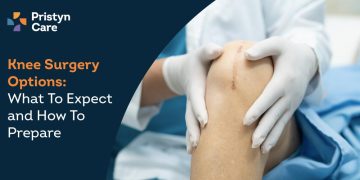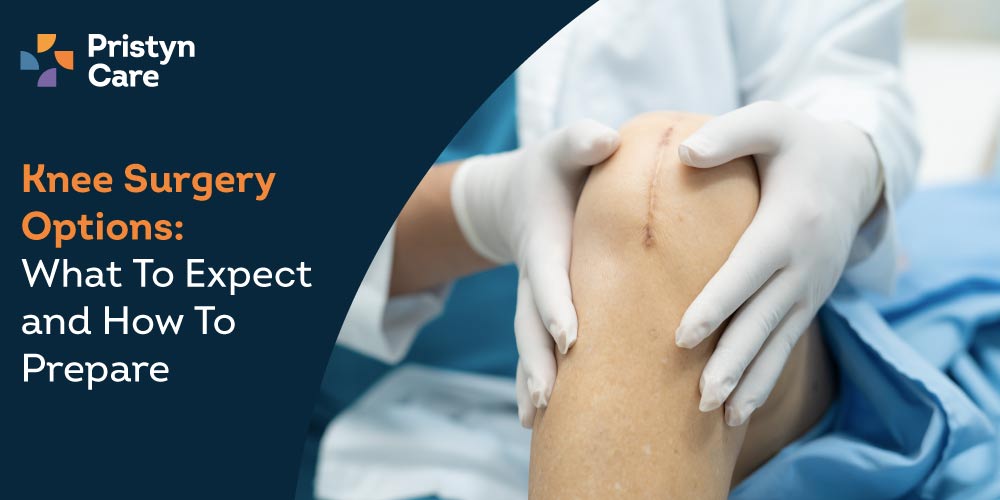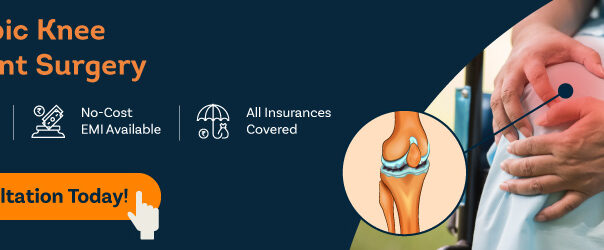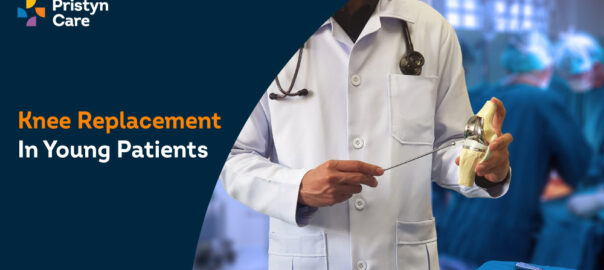![]() Views: 51
Views: 51
Knee Surgery Options: What To Expect And How To Prepare
Dedicated Support at Every Step!
Our Doctors are available 24 hours a day, 7 days a week to help you!
Whether you are exploring minimally invasive procedures such as arthroscopy or considering a more extensive intervention like a total knee replacement, each surgical option comes with its specific benefits, risks, and recovery paths.
In this blog, we will talk about the various surgical treatments available, from the initial diagnosis to postoperative care. Our goal is to equip you with essential information that will help you make informed decisions together with your healthcare provider. We will also offer practical tips on preparing both physically and mentally for surgery to ensure the best possible outcomes.
Table of Contents
Types of Knee Surgery
Before moving on to the different knee surgery options, diagnosis, what to expect and how to prepare for knee surgeries, we will take a look at the types of knee surgery.
Arthroscopy
Knee arthroscopy is a minimally invasive procedure often used to diagnose and treat issues within the joint. This technique involves small incisions through which a camera and surgical tools are inserted, allowing surgeons to address a range of problems from torn meniscus to loose bone fragments.
Partial Knee Replacement
A partial knee replacement, or unicompartmental knee replacement, is suited for patients whose damage is limited to a specific part of the knee. During this procedure, only the affected compartment is replaced, preserving much of the knee's natural structure. This often results in a more natural feeling in the knee post-surgery, a quicker recovery, and less pain compared to total knee replacements.
Total Knee Replacement
Total knee replacement involves removing damaged bone and cartilage from the entire knee joint and replacing it with an artificial joint. This procedure is typically recommended for severe arthritis or damage that affects multiple compartments of the knee. It helps to alleviate pain and restore function, though it involves a longer recovery period.
Knee Revision Surgery
Knee revision surgery may be necessary if a previous knee replacement fails. This complex procedure involves replacing the old prosthesis with a new one, often requiring extensive preparation and specialised implants. Recovery and outcomes vary, depending on the extent of the issue and the patient's overall health.
Alternative Surgical Techniques
In cases where traditional knee replacement might be too risky or if a patient seeks alternatives, other techniques such as osteotomy or even non-surgical options might be considered. These methods can help alleviate symptoms and delay the need for joint replacement
No Cost EMI, Hassle-free Insurance Approval
Diagnosis and Treatment Planning
Symptoms That Indicate the Need for Surgery
Knee pain requiring surgical intervention often manifests as persistent discomfort exacerbated by activities, swelling that persists despite rest and medication, and a significant reduction in joint mobility.
Symptoms like chronic knee stiffness, severe pain that hampers daily activities, and failure of non-surgical treatments (such as physical therapy and medication) to alleviate symptoms may indicate the need for surgery.
Diagnostic Tests and Their Role
Diagnostic procedures for knee issues are crucial in deciding the need and type of surgery. Common diagnostic tests include X-rays and MRI scans, which help visualise the extent of joint damage.
Advanced tests like arthroscopy may also be employed to assess internal joint health directly. These tests are vital for pinpointing specific problems within the knee, such as ligament tears or cartilage loss.
Choosing the Right Type of Knee Surgery
The choice of surgery depends on the knee's condition, affected areas, and the patient's overall health and activity level. Options range from partial knee replacement, suitable for localised damage, to total knee replacement for extensive joint damage.
The surgeon's recommendations will consider the diagnostic results, the patient's lifestyle needs, and potential surgery benefits versus risks.
Preparing for Knee Surgery
Preparing for knee surgery? Understanding what to expect and how to prepare for knee surgeries is crucial. Begin with comprehensive pre-surgical medical evaluations to optimise your health for the best outcomes. Let us get to some more finer details.
Pre-surgical Medical Evaluations
Pre-surgical evaluations typically include detailed medical history assessments, physical examinations, and necessary blood tests to ensure the patient is fit for surgery. It's essential to discuss all medications and any conditions that might affect surgery outcomes, such as allergies or chronic diseases.
Lifestyle and Dietary Adjustments
Patients may need to adjust their diet and lifestyle to reduce surgery risks and enhance recovery outcomes. This includes nutritional adjustments to support healing and avoiding substances that could complicate surgery or recovery, such as tobacco and alcohol.
Exercises to Prepare for Surgery
Engaging in specific exercises pre-surgery can strengthen the muscles around the knee, aiding in quicker post-surgery recovery. Physical therapists often prescribe tailored exercise regimes that focus on enhancing joint mobility and muscle strength.
What to Expect During Surgery
Anaesthesia and Its Effects
Knee surgeries typically require either general anaesthesia, which induces sleep, or regional anaesthesia, which numbs the lower body. Anesthesiologists choose the type based on the surgery's nature and patient health, ensuring comfort and minimising pain during the procedure.
Step-by-Step Process of Common Surgeries
Common knee surgeries involve removing damaged joint components and replacing them with artificial parts. The procedure includes making an incision, preparing the bone for the prosthetic, and then inserting and securing the new joint.
Intraoperative Care
During surgery, continuous monitoring is essential to manage vital signs and respond to any immediate complications. The surgical team ensures the patient's stability throughout the procedure.
Postoperative Care and Recovery
- Immediate Postoperative Care: Immediate care post-surgery involves managing pain, preventing infection, and monitoring for any signs of complications. Patients usually begin physical therapy very soon after surgery to aid recovery.
- Rehabilitation and Physical Therapy: Rehabilitation is crucial and starts early to encourage healing and mobility. Therapy programs are designed to gradually increase the knee's strength and range of motion, essential for a successful recovery.
- Long-term Care for Surgical Knee: Long-term care includes ongoing physical therapy, regular medical check-ups, and possibly lifestyle modifications to protect the new joint and promote overall joint health. Patients are advised on maintaining a healthy weight and avoiding high-impact activities that could jeopardise the knee's longevity
Potential Risks and Complications
Common Surgical Risks
Knee replacement surgery, while generally safe, does carry risks. Common complications include stiffness or limited range of motion, clicking or clunking noises from the artificial joint, and implant wear or failure.
Infection is a serious but rare complication, occurring in less than 2% of cases. Blood clots, including deep vein thrombosis (DVT) and pulmonary embolism, are also potential risks following surgery.
How to Manage Complications
Managing complications effectively involves early detection and appropriate intervention. For infections, prompt treatment with antibiotics or further surgical intervention might be necessary.
Physical therapy plays a crucial role in managing stiffness and improving mobility. For blood clots, doctors often recommend anticoagulant medications and encourage early mobilisation to enhance blood flow.
Signs of Concern Post-Surgery
Signs that warrant immediate medical attention include increased redness, swelling, warmth around the knee, severe or increasing pain, and fever—indications of possible infection.
Additionally, sudden shortness of breath or chest pain could be symptoms of a pulmonary embolism, requiring urgent care.
Life After Knee Surgery
Expected Outcomes and Quality of Life
Most patients experience significant pain relief and improved mobility after knee replacement. The majority of knee replacements last 15-20 years or more, significantly enhancing the quality of life. However, patients are advised to avoid high-impact activities to extend the lifespan of the artificial joint.
Adjustments in Daily Activities
Post-surgery, patients may need to make several adjustments in daily activities to accommodate the new knee. This includes using assistive devices like canes or walkers initially and avoiding activities that put excessive strain on the knee.
Lifestyle adaptations and home modifications, such as removing loose rugs and adding supportive seating, can also aid recovery and prevent falls.
Follow-up Care and Check-ups
Regular follow-up appointments are crucial for monitoring the progress of recovery and early detection of potential complications. Initially, these check-ups may happen frequently but will taper off as recovery progresses.
During these visits, X-rays might be taken to assess the position of the implant and discuss any concerns with the surgeon.
Conclusion
Exploring knee surgery options and preparing for the procedure are pivotal steps toward regaining mobility and enhancing your quality of life. With a clear understanding of what to expect and meticulous preparation, you can navigate your surgical journey with confidence.
From the initial diagnosis to postoperative care, each phase is crucial in ensuring optimal outcomes. Successful recovery often hinges on effective pre-surgery planning, understanding potential risks, and adhering to prescribed rehabilitation protocols. Engage actively with your healthcare team to achieve the best possible results from your knee surgery.











